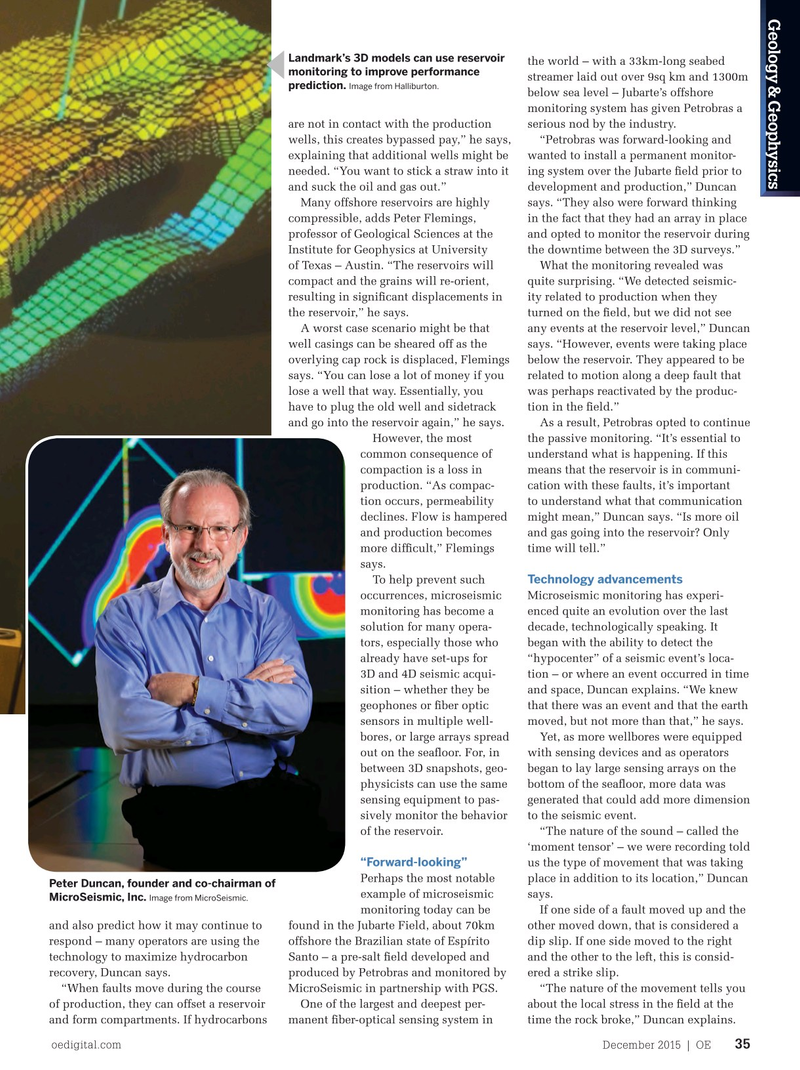
Page 33: of Offshore Engineer Magazine (Dec/Jan 2015)
Read this page in Pdf, Flash or Html5 edition of Dec/Jan 2015 Offshore Engineer Magazine
Geology & Geophysics
Landmark’s 3D models can use reservoir the world – with a 33km-long seabed monitoring to improve performance streamer laid out over 9sq km and 1300m prediction. Image from Halliburton. below sea level – Jubarte’s offshore monitoring system has given Petrobras a are not in contact with the production serious nod by the industry.
wells, this creates bypassed pay,” he says, “Petrobras was forward-looking and explaining that additional wells might be wanted to install a permanent monitor- needed. “You want to stick a straw into it ing system over the Jubarte feld prior to and suck the oil and gas out.” development and production,” Duncan
Many offshore reservoirs are highly says. “They also were forward thinking compressible, adds Peter Flemings, in the fact that they had an array in place professor of Geological Sciences at the and opted to monitor the reservoir during
Institute for Geophysics at University the downtime between the 3D surveys.” of Texas – Austin. “The reservoirs will What the monitoring revealed was compact and the grains will re-orient, quite surprising. “We detected seismic- resulting in signifcant displacements in ity related to production when they the reservoir,” he says. turned on the feld, but we did not see
A worst case scenario might be that any events at the reservoir level,” Duncan well casings can be sheared off as the says. “However, events were taking place overlying cap rock is displaced, Flemings below the reservoir. They appeared to be says. “You can lose a lot of money if you related to motion along a deep fault that lose a well that way. Essentially, you was perhaps reactivated by the produc- have to plug the old well and sidetrack tion in the feld.” and go into the reservoir again,” he says. As a result, Petrobras opted to continue
However, the most the passive monitoring. “It’s essential to common consequence of understand what is happening. If this compaction is a loss in means that the reservoir is in communi- production. “As compac- cation with these faults, it’s important tion occurs, permeability to understand what that communication declines. Flow is hampered might mean,” Duncan says. “Is more oil and production becomes and gas going into the reservoir? Only more diffcult,” Flemings time will tell.” says.
Technology advancements
To help prevent such occurrences, microseismic Microseismic monitoring has experi- monitoring has become a enced quite an evolution over the last solution for many opera- decade, technologically speaking. It tors, especially those who began with the ability to detect the already have set-ups for “hypocenter” of a seismic event’s loca- 3D and 4D seismic acqui- tion – or where an event occurred in time sition – whether they be and space, Duncan explains. “We knew geophones or fber optic that there was an event and that the earth sensors in multiple well- moved, but not more than that,” he says.
of Houston-based MicroSeismic, Inc. bores, or large arrays spread Yet, as more wellbores were equipped “However, when used offshore, it does out on the seafoor. For, in with sensing devices and as operators allow you to accelerate your response to between 3D snapshots, geo- began to lay large sensing arrays on the whatever is going on in the subsurface.” physicists can use the same bottom of the seafoor, more data was
So, where there was once a dearth of sensing equipment to pas- generated that could add more dimension data, the offshore is now facing what sively monitor the behavior to the seismic event. some are calling an “information explo- of the reservoir. “The nature of the sound – called the sion.” In response, it’s scurrying to build ‘moment tensor’ – we were recording told “Forward-looking” better models so that operators can us the type of movement that was taking understand in real time the goings-on Perhaps the most notable place in addition to its location,” Duncan
Peter Duncan, founder and co-chairman of in their reservoirs. As better models are example of microseismic says.
MicroSeismic, Inc. Image from MicroSeismic.
built, operators can make decisions more monitoring today can be If one side of a fault moved up and the quickly, ultimately realizing higher prof- and also predict how it may continue to found in the Jubarte Field, about 70km other moved down, that is considered a its during an economic downturn. respond – many operators are using the offshore the Brazilian state of Espírito dip slip. If one side moved to the right technology to maximize hydrocarbon Santo – a pre-salt feld developed and and the other to the left, this is consid-
A glimpse – by sound – into the earth recovery, Duncan says. produced by Petrobras and monitored by ered a strike slip.
Realizing that microseismic monitoring “When faults move during the course MicroSeismic in partnership with PGS. “The nature of the movement tells you can paint a moving picture of how a res- of production, they can offset a reservoir One of the largest and deepest per- about the local stress in the feld at the ervoir is responding during production and form compartments. If hydrocarbons manent fber-optical sensing system in time the rock broke,” Duncan explains. oedigital.com December 2015 | OE 35 034_OE1215_G&G1_Heather.indd 35 11/20/15 6:53 PM

 32
32

 34
34